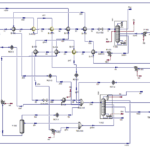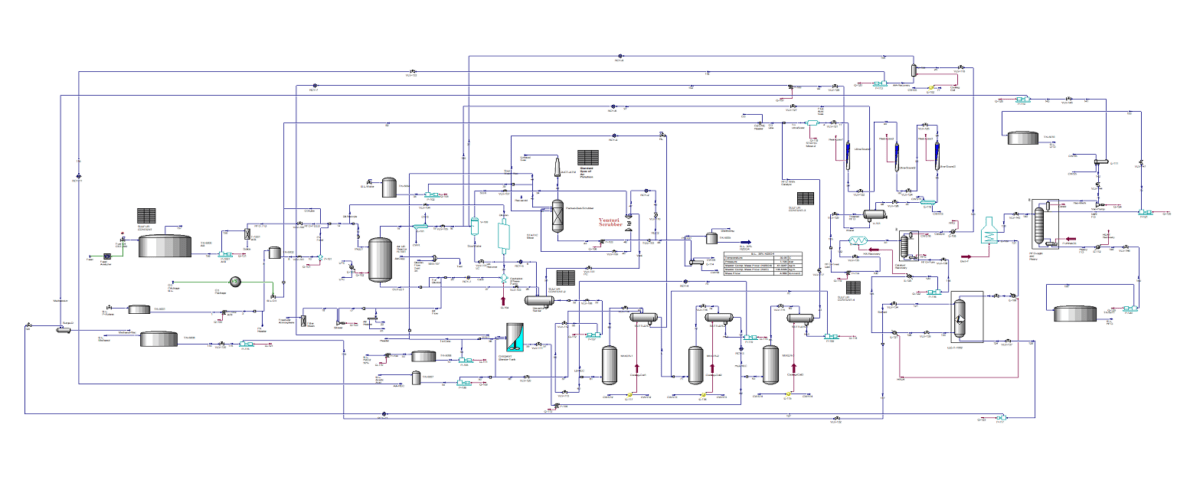Introduction
The Heavy Fuel Oil Oxidative Desulfurization (HFO-ODS) unit, with a capacity of 300,000 barrels per day (BPD), is designed to reduce the sulfur content in heavy fuel oils (HFO). This process utilizes oxidative methods to convert sulfur-containing compounds into forms that can be easily separated from the fuel. Given the stringent environmental regulations and the increasing emphasis on reducing sulfur emissions, this unit holds significant importance. The implementation of such a unit is crucial for complying with environmental standards and minimizing the ecological impact of heavy fuel oil usage.
Overview of The Desulfurization Process
The Oxidative Desulfurization (ODS) unit is a critical process in refineries aimed at reducing the sulfur content in heavy fuels such as diesel and fuel oil. This process is specifically designed to remove sulfur-containing compounds, such as thiophenes and their derivatives, which are difficult to eliminate through conventional desulfurization methods like hydrodesulfurization (HDS). Various desulfurization techniques have been developed, each tailored to address different types of sulfur compounds and fuel varieties. Below, we will discuss some of these methods in detail.
Hydrodesulfurization (HDS)
Hydrodesulfurization (HDS) is the most widely used desulfurization method, particularly for light and medium crude oils. This process involves the catalytic hydrogenation of sulfur-containing compounds at high temperatures (300-400°C) and high pressures (30-130 bar).
Process: In HDS, hydrogen gas and oil are mixed and passed over a metallic catalyst, typically molybdenum or cobalt supported on an alumina base. The hydrogen reacts with the sulfur compounds, converting them into hydrogen sulfide (H₂S), which is then separated from the system.
Advantages: This method is highly effective for simple sulfur compounds (such as mercaptans, sulfides, and thiophenes) in lighter fractions of oil.
Limitations: HDS is less effective for refractory sulfur compounds (such as dibenzothiophenes) in heavy oils. Additionally, the process requires significant amounts of hydrogen, high temperatures, and high pressures, which increase costs and reduce efficiency when applied to heavy oils.
Adsorptive Desulfurization (ADS)
Adsorptive Desulfurization (ADS) uses adsorbents to remove sulfur compounds directly from fuels.
- Process: Adsorbents like activated carbon, zeolites, metal oxides, or metal-organic frameworks (MOFs) are used to selectively capture sulfur compounds from the fuel stream. These materials have high surface areas and can be tailored for specific sulfur compounds.
- Advantages: Effective at low sulfur concentrations, requires no hydrogen, and can operate at mild conditions. It’s often used as a finishing process to further reduce sulfur levels in treated fuels.
- Limitations: Adsorbent regeneration and sulfur selectivity can limit ADS efficiency. Adsorption capacity also decreases over time as adsorbent materials become saturated.
Oxidative Desulfurization (ODS)
Oxidative Desulfurization (ODS) is an alternative to HDS that uses an oxidizing agent to convert sulfur compounds into sulfones and sulfoxides, which can then be removed by extraction or adsorption.
- Process: Common oxidants include hydrogen peroxide, organic peroxides, or air. Catalysts like acetic acid can accelerate the oxidation. Ultrasound or UV radiation is sometimes used to enhance reaction rates, especially for refractory sulfur compounds.
- Advantages: Operates at mild conditions (ambient temperature and pressure), and is effective for refractory sulfur compounds in both light and heavy oils. The process is more energy-efficient and does not require hydrogen.
- Limitations: The need for oxidants and post-treatment separation of oxidized sulfur compounds can add complexity.
Mechanism of Oxidative Desulfurization (ODS) Process:
In the ODS process, sulfur-containing compounds present in heavy fuel are oxidized in the presence of an oxidizing agent (such as hydrogen peroxide or ozone) and a catalyst (such as Lewis acids or transition metals). This oxidation converts the sulfur compounds into sulfones or sulfoxides, which can be easily separated from the fuel.
Key Stages of the Process:
- Oxidation: Sulfur-containing compounds are oxidized in the presence of the oxidizing agent and catalyst.
- Extraction: The oxidized sulfur compounds (sulfones) are transferred from the fuel phase to an aqueous or solid phase.
- Separation: The fuel and aqueous phases are separated, resulting in fuel with reduced sulfur content.
Simulation
Aspen HYSYS is a powerful process simulation software widely used in the oil and gas, petrochemical, refining, and chemical industries. Its versatility and high accuracy in modeling hydrocarbon processes make it particularly valuable for applications such as desulfurization, refining, gas processing, and natural gas liquefaction. Aspen HYSYS provides access to a comprehensive range of thermodynamic models, including Peng-Robinson, SRK (Soave-Redlich-Kwong), NRTL (Non-Random Two-Liquid), and others, enabling precise simulation of phase behavior and physical properties under various conditions. This allows users to model processes with diverse feedstocks and mixtures, ranging from light gases to heavy hydrocarbons.
Due to its accurate hydrocarbon thermodynamic models and its capability to simulate complex reactions, Aspen HYSYS is particularly well-suited for simulating desulfurization processes. For instance, in oxidative desulfurization (ODS), HYSYS enables the simulation of reactors, scrubbing systems, extraction columns, and solvent recovery units. This capability is crucial for designing and optimizing desulfurization processes that comply with stringent sulfur emission standards, as well as for improving the overall efficiency of fuel refining operations. The software’s robust simulation environment ensures reliable predictions and supports the development of cost-effective and environmentally compliant solutions in the refining industry.
Simulation in Aspen HYSYS:
To simulate this unit in Aspen HYSYS, the following steps can be followed:
A. Defining Input Streams:
Heavy Fuel: Hydrocarbon compounds along with sulfur-containing compounds such as thiophenes.
Oxidizing Agent: Typically hydrogen peroxide (H₂O₂) or ozone (O₃).
Catalyst: Various catalysts such as Lewis acids or transition metals can be used.
B. Selecting Operational Units:
Reactor: For carrying out the oxidation reaction of sulfur compounds. Continuous Stirred-Tank Reactors (CSTR) or Plug Flow Reactors (PFR) can be used.
Separator: For separating the fuel and aqueous phases after oxidation. Simple separators or extraction columns can be employed.
Heat Exchangers: For controlling the process temperature and cooling the streams.
C. Setting Process Parameters:
-
Temperature and Pressure: The optimal temperature and pressure for the oxidation reaction must be set. Typically, the temperature ranges between 50 to 100°C, and the pressure is atmospheric or slightly higher.
- Molar Ratio: The molar ratio of the oxidizing agent to sulfur compounds must be carefully adjusted to ensure complete oxidation.
- Residence Time: The residence time in the reactor should be set to ensure the reaction proceeds to completion.
Stream Properties
The properties of the heavy fuel from Lavan and the pure components used in this simulation are derived from Lavan Refinery reports and experimental analysis.
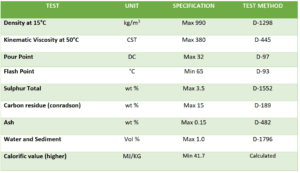
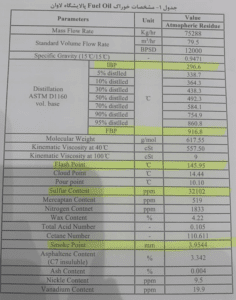
ASTM D-1160 Distillation:
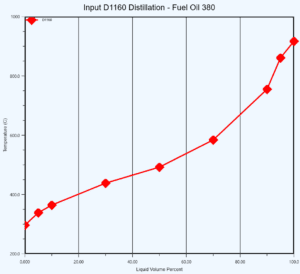
Sulfur Content: (Bulk Properties~3.5 Wt. %)

Process Flow Diagram (Aspen HYSYS Version 14.00)
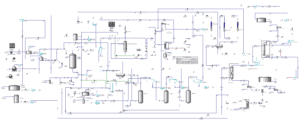
Regeneration Column Profiles
The fluid density within the column varies along its length. These variations can be attributed to differences in fluid composition (e.g., changes in the ratio of light to heavy components) or fluctuations in temperature and pressure along the column.
The molecular weight may also change due to variations in fluid composition or mass and energy transfer processes between the trays. These data can be utilized to optimize column performance and analyze the distribution of components along the column.
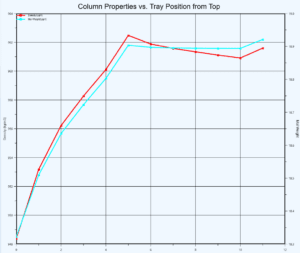
Liquid-Liquid Extraction:
Temperature variations along the column indicate the distribution of energy and heat transfer between the trays.
Typically, the temperature is lower at the top of the column (due to the presence of lighter components with lower boiling points) and increases toward the bottom (due to the presence of heavier components with higher boiling points).
This profile can be used to evaluate the column’s efficiency in separating different components and to control the temperature across various trays.
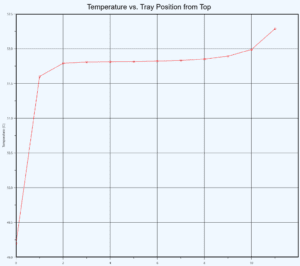
Molar Flow:
This graph illustrates the molar flow of light and heavy fluids along the column.
The flow of the light fluid is typically higher at the top of the column, while the flow of the heavy fluid increases toward the bottom.
These data can be used to analyze flow distribution and optimize the performance of the column.
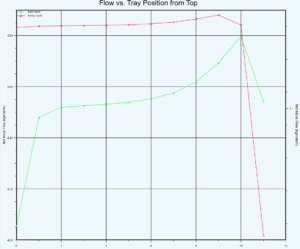
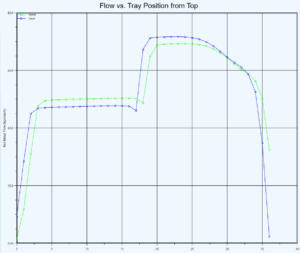
Conclusion:
The simulation of the Oxidative Desulfurization (ODS) unit for heavy fuels in Aspen HYSYS is a complex, multi-stage process that requires a deep understanding of chemical mechanisms, appropriate selection of operational units, and precise adjustment of process parameters. This process effectively oxidizes refractory sulfur compounds, such as thiophenes, converting them into compounds that can be easily separated from the fuel. Through accurate simulation, the process can be optimized, significantly enhancing the unit’s efficiency.
SANILCO, leveraging its team of experts and extensive experience, along with its proficiency in advanced simulation software such as Aspen HYSYS, possesses full capability in simulating and optimizing oxidative desulfurization units. Utilizing cutting-edge technical knowledge and practical expertise in the refining and petrochemical sectors, the company is able to provide efficient and cost-effective solutions for reducing sulfur content in heavy fuels. This capability plays a crucial role in meeting stringent environmental regulations and improving the sustainability of fuel production processes.
